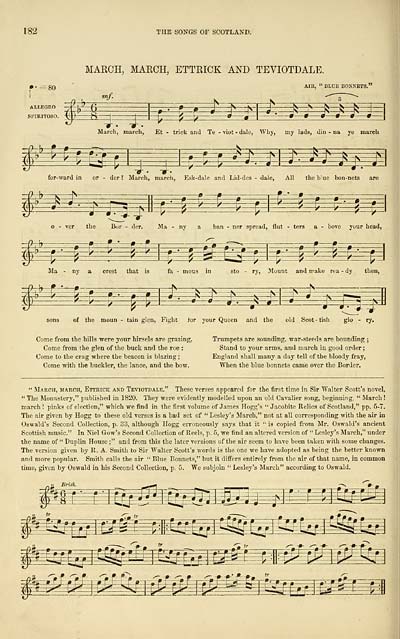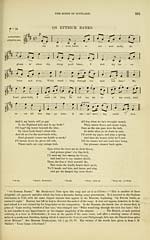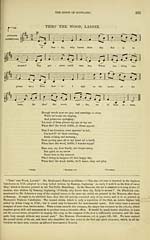Glen Collection of printed music > Printed music > Wood's edition of the songs of Scotland
(206) Page 182 - March, march Ettrick and Teviotdale
Download files
Complete book:
Individual page:
Thumbnail gallery: Grid view | List view

182
THE SONGS OF SCOTLAND.
MARCH, MAECH, ETTEICK AND TEVIOTDALE.
••=80
AIR, " BLUE BONNETS."
mf.
I
T-
£
-¥■ — /=
jL_j u *=fcrfc3S
March, march, Et - trick and Te - viot - dale, Why, my lads, din - na ye march
17 V V-f =P*-
^=3=
£=N=^=^
=p^=?
fS— s-
=£
3fc=
for-ward in or - der ? March, march, EsU-dale and Lid-des - dale, All the b : ue bon-net3 are
fcfc
^=3U = * =r ^ = J=p==5=^-|
if
-/-
o - ver the Bur - der. Ma - ny a ban - ner spread, flut - tere a - bove your head,
fc . — • — f ' — *— i— Cm r— zl — P-
--^^
^EE^k^E^^i
¥^r-
Ma - ny a crest that is
fa - mous in
ry, Mount and irake rea - dy
then,
!£_• 9~Z __J
3S^=£=
£
m
5?
£=a
^
sons of the moun - tain glen, Fight tor your Queen and the old Scot-tish glo - ry.
Come from the hills were your hirsels are grazing.
Come from the glen of the buck and the roe :
Come to the crag where the beacon is blazing ;
Come with the buckler, the lance, and the bow.
Trumpets are sounding, war-steeds are bounding ;
Stand to your arms, and march in good order ;
England shall many a day tell of the bloody fray,
When the blue bonnets came over the Border.
" March, march, Ettrick and Teviotdale." These verses appeared for the first time in Sir Walter Scott's novel,
" The Monastery," published in 1820. They were evidently modelled upon an old Cavalier song, beginning, " March !
march ! pinks of election," which we find in the first volume of James Hogg's "Jacobite Relics of Scotland," pp. 5-7.
The air given by Hogg to these old verses is a bad set of " Lesley's March," not at all corresponding with the air in
Oswald's Second Collection, p. 33, although Hogg erroneously says that it " is copied from Mr. Oswald's ancient
Scottish music." In Niel Gow's Second Collection of Reels, p. 5, we find an altered version of " Lesley's March," under
the name of " Duplin House ;" and from this the later versions of the air seem to have been taken with some changes.
The version given by R. A. Smith to Sir Walter Scott's words is the one we have adopted as being the better known
and more popular. Smith calls the air " Blue Bonnets," but it differs entirely from the air of that name, in common
time, given by Oswald in his Second Collection, p. 5. We subjoin " Lesley's March" according to Oswald.
pmmm^rn
E£f3S3
?-^F— F
meg^^mm^^^z^^^^
g§ g=agEggsss
$mm g&&mmg£& mm z&&
THE SONGS OF SCOTLAND.
MARCH, MAECH, ETTEICK AND TEVIOTDALE.
••=80
AIR, " BLUE BONNETS."
mf.
I
T-
£
-¥■ — /=
jL_j u *=fcrfc3S
March, march, Et - trick and Te - viot - dale, Why, my lads, din - na ye march
17 V V-f =P*-
^=3=
£=N=^=^
=p^=?
fS— s-
=£
3fc=
for-ward in or - der ? March, march, EsU-dale and Lid-des - dale, All the b : ue bon-net3 are
fcfc
^=3U = * =r ^ = J=p==5=^-|
if
-/-
o - ver the Bur - der. Ma - ny a ban - ner spread, flut - tere a - bove your head,
fc . — • — f ' — *— i— Cm r— zl — P-
--^^
^EE^k^E^^i
¥^r-
Ma - ny a crest that is
fa - mous in
ry, Mount and irake rea - dy
then,
!£_• 9~Z __J
3S^=£=
£
m
5?
£=a
^
sons of the moun - tain glen, Fight tor your Queen and the old Scot-tish glo - ry.
Come from the hills were your hirsels are grazing.
Come from the glen of the buck and the roe :
Come to the crag where the beacon is blazing ;
Come with the buckler, the lance, and the bow.
Trumpets are sounding, war-steeds are bounding ;
Stand to your arms, and march in good order ;
England shall many a day tell of the bloody fray,
When the blue bonnets came over the Border.
" March, march, Ettrick and Teviotdale." These verses appeared for the first time in Sir Walter Scott's novel,
" The Monastery," published in 1820. They were evidently modelled upon an old Cavalier song, beginning, " March !
march ! pinks of election," which we find in the first volume of James Hogg's "Jacobite Relics of Scotland," pp. 5-7.
The air given by Hogg to these old verses is a bad set of " Lesley's March," not at all corresponding with the air in
Oswald's Second Collection, p. 33, although Hogg erroneously says that it " is copied from Mr. Oswald's ancient
Scottish music." In Niel Gow's Second Collection of Reels, p. 5, we find an altered version of " Lesley's March," under
the name of " Duplin House ;" and from this the later versions of the air seem to have been taken with some changes.
The version given by R. A. Smith to Sir Walter Scott's words is the one we have adopted as being the better known
and more popular. Smith calls the air " Blue Bonnets," but it differs entirely from the air of that name, in common
time, given by Oswald in his Second Collection, p. 5. We subjoin " Lesley's March" according to Oswald.
pmmm^rn
E£f3S3
?-^F— F
meg^^mm^^^z^^^^
g§ g=agEggsss
$mm g&&mmg£& mm z&&
Set display mode to: Large image | Transcription
Images and transcriptions on this page, including medium image downloads, may be used under the Creative Commons Attribution 4.0 International Licence unless otherwise stated. ![]()
| Special collections of printed music > Glen Collection of printed music > Printed music > Wood's edition of the songs of Scotland > (206) Page 182 - March, march Ettrick and Teviotdale |
|---|
| Permanent URL | https://digital.nls.uk/91340215 |
|---|
| Description | Scottish songs and music of the 18th and early 19th centuries, including music for the Highland bagpipe. These are selected items from the collection of John Glen (1833 to 1904). Also includes a few manuscripts, some treatises, and other books on the subject. |
|---|
| Description | The Glen Collection and the Inglis Collection represent mainly 18th and 19th century Scottish music, including Scottish songs. The collections of Berlioz and Verdi collected by bibliographer Cecil Hopkinson contain contemporary and later editions of the works of the two composers Berlioz and Verdi. |
|---|

